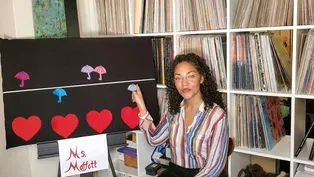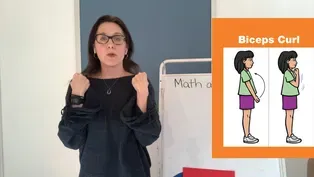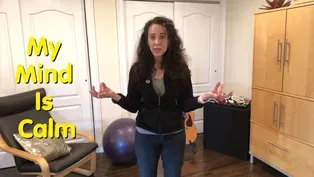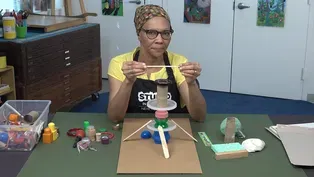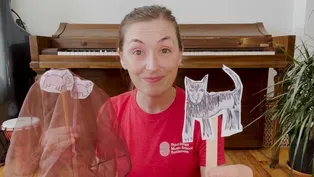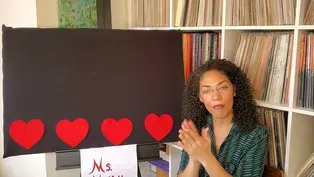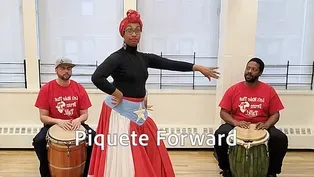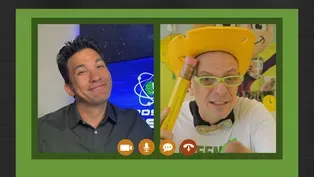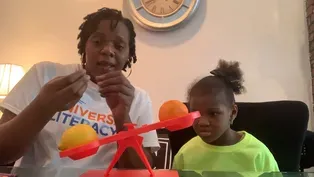
Can You Hear the Long “o” In Shadow?
4/30/2021 | 57m 45sVideo has Closed Captions
Make instruments to explore pitch, learn a dance from Uganda, read SHADOW.
Make instruments to explore pitch, learn a dance from Uganda, read SHADOW, change sounds – long I, long o. LET’S LEARN helps children ages 3-8 with at-home learning. One-hour programs feature instruction by educators and virtual field trips.
Problems with Closed Captions? Closed Captioning Feedback
Problems with Closed Captions? Closed Captioning Feedback
Let's Learn is a local public television program presented by THIRTEEN PBS

Can You Hear the Long “o” In Shadow?
4/30/2021 | 57m 45sVideo has Closed Captions
Make instruments to explore pitch, learn a dance from Uganda, read SHADOW, change sounds – long I, long o. LET’S LEARN helps children ages 3-8 with at-home learning. One-hour programs feature instruction by educators and virtual field trips.
Problems with Closed Captions? Closed Captioning Feedback
How to Watch Let's Learn
Let's Learn is available to stream on pbs.org and the free PBS App, available on iPhone, Apple TV, Android TV, Android smartphones, Amazon Fire TV, Amazon Fire Tablet, Roku, Samsung Smart TV, and Vizio.
Providing Support for PBS.org
Learn Moreabout PBS online sponsorshipMore from This Collection
Video has Closed Captions
Read SCHOOL BUS and draw one, learn about prefixes and pitch, build sculptures. (57m 48s)
Running and Counting Both End in “ing”!
Video has Closed Captions
Move to improve, find the missing number, learn songs from Ghana, read ABUELITA’S SECRET. (58m 17s)
What Sound Does “aw” Make in Draw?
Video has Closed Captions
Read a story, discover "au" and "aw," learn about density, count, and move with music. (56m 58s)
Can You Find the Short “u” in Subtract?
Video has Closed Captions
Help Super Grover 2.0 solve a prickly problem, read ALL THE WAYS TO BE SMART. (56m 19s)
What Sound Does “gl” Make in Glove?
Video has Closed Captions
Play the glockenspiel, help Super Grover 2.0 make a cart move, read TWO WOOL GLOVES. (58m 9s)
Incredible Starts with Short “i”!
Video has Closed Captions
Solve problems with Super Grover 2.0, catch a rainbow, hear a piano sound like a cuckoo. (56m 9s)
What’s the Sound of “oo” in Book?
Video has Closed Captions
Explore animals’ form and function, sing about the 3 little pigs, read THE LITTLE BOX. (58m 15s)
We’re Reducing, Reusing and Recycling!
Video has Closed Captions
Learn all about rhythm and the number 9, read A BAG IN THE WIND. (56m 17s)
Video has Closed Captions
Learn to dance bomba and grow food in a city, read WOLF CUB’S SONG. (55m 20s)
How Many Syllables are in Invent?
Video has Closed Captions
Invent your own instrument, make 10 to add numbers to 20, read ONE GOLDEN RULE AT SCHOOL. (57m 36s)
Video has Closed Captions
Learn about the science behind mind reading, count shells, read MY BIG FAMILY. (57m 27s)
Which is Heavier: One Apple or Two Apples?
Video has Closed Captions
Defy gravity, learn secret code words for fast and slow in music, read WHOOO KNEW? (58m 5s)
Providing Support for PBS.org
Learn Moreabout PBS online sponsorship[upbeat music] - [Narrator] Ready to learn?
- Hi.
- Hi.
- [Narrator] It's time to share a story, read and write.
- Let's read it back.
- [Narrator] Discover science, sing.
♪ Somewhere ♪ - [Narrator] Play and so much more.
- Cupcake.
- Very good.
Stay tuned for lessons and activities.
- We're gonna start making some words, isn't that fun?
- [Narrator] Funding for this program was provided by the JPB Foundation.
- Hello everyone.
- Hi everybody!
My name is Maria.
And this is-- - Miller.
- Miller, and Miller is?
- Nine years old.
- And he's in?
- Third grade.
- Third grade!
And this is our sweet Hopper.
I'm not gonna bother him too much, 'cause I think he's about to take a nap.
He got two walks today, so he is quite tired.
- Hi!
Hopper say hi.
Oh, I think he's about to fall asleep.
So Miller, you wanna introduce the book to them today?
- "Shadows."
- "Shadow."
And what we have noticed is that the word shadow is making a shadow of itself.
Therefore, the word is backwards, spelled W-- - O-D-A-H-S. - I don't even know how to pronounce that word!
Wada, Wad-Ash, Wad-ash, something like that?
Right?
- Wadash.
- Wadash, yeah.
Something like that.
- But, I don't think it would be a S-H. - Yeah.
- Because H, because as you were saying is S-H. - Yeah.
So the author and the illustrator, her name is Susie Lee.
And we see a little girl here, and I believe she's the main character, and she is making shadows.
And you know, one thing we haven't told them about the book, what is special about the book?
- It's horizontal.
- It's horizontal instead of vertical, you know, most of our books open like, wait, like this, but this book opens horizontally from top to bottom.
Oh, he's showing us an example.
Yes, most books open like that, but this book opens like that, okay.
So there are no words in the book, right?
So when going to make up a story, right, we're going to make up a story, right Miller, and I think we can have a lot of fun, okay?
Now our main character doesn't have a name.
What should we call her?
- Um... Mia?
- Mia!
After your sister!
I love that name!
Okay, so we're going to call the main character Mia.
Okay.
Let's get started.
So our main character, Mia, has gone into what part of the house, Miller?
- The garage!
- How do you know it's the garage?
- Because there's bikes, a broom, there's usually, like maybe it's her basement too.
- Oh, you're right!
It could be the basement, because our basement has a string that you pull.
So she's either in the garage or the basement.
And one thing-- - Maybe the attic!
- Or the attic!
Yeah, cause there are parts in our houses that can be quite dark, right?
So she's pulled out-- - Attic, um, garage, and basement!
- And basement.
So, and it's so, the light that you pull is usually a small light.
So it does create shadows.
So she is going to have a lot of fun with the shadows.
So let's get started.
- There's also no words.
- And also no words!
So let's have fun with it.
So Mia is, what is she doing?
- She's walking on a shadow.
- Yeah, she's walking on her tippy toes.
Almost like she's dancing, right.
So, okay.
So she is realizing, I can make shadows in here, and I think she's going to have a lot of fun with it.
So she crouches down, and what does she make?
- A eagle.
- An eagle.
I was just going to say bird, but Miller knew it looks like an eagle.
Can you make an eagle?
Can you make an eagle?
- Maybe something-- - Like this.
You want to do it with us?
Make an eagle like that.
And if you had a little light to block, it would be, it would make a nice shadow.
Okay.
So she is making an eagle, and oh, and now what did she do?
- She like threw the eagle up in the air.
- She let the eagle go!
Okay.
Let's continue.
Okay.
Oh, and now what did she grab?
What did she grab?
- A shoe!
- Is that a shoe?
Oh, she bought the shoe from on top and she-- - And it's like broken.
- Oh, it is broken, 'cause we kind of, we tend to throw things that are broken in our attics and basements instead of storing it away.
So she's holding the broken shoe, she's jumping in the air, and what does it look like?
- Like a scary monster that's like kind of like a wolf.
- It kind of looks like a wolf and the hose looks like a snake.
- And there's like, it's like a crocodile.
- Yeah, a crocodile.
Oh, the eagle is still there.
- Wait, what happened to the bike?
- I don't know, but it is still making a shadow.
How lovely.
She is heavy.
Oh gosh, I'm confused.
Which way do I turn?
Which way do I turn, Miller?
Oh, this way.
Okay.
- And Mia is- - And now Mia has grabbed the vacuum cleaner.
And what does it turn into?
- A elephant.
- An elephant!
And oh, she looks, what does she look like?
- A queen?
- Like a queen or a princess.
- There's a bunny and-- - A snake, yeah.
Oh, is this like the wolf with the eyes?
Right?
- And look, there's the crocodile.
- That's the crocodile.
Okay.
Let's continue.
Help me turn the right way.
Oh my goodness.
- Now there's nothing there!
- Oh, there's nothing on this side.
- Except for her and the shadow.
- Oh, the shadow joined her in real life.
- Oh no, the wolf is starting to-- - Oh, so are the characters from the shadow joining her in real life?
And what does she turn into?
- A queen?
- Like a queen.
- On like a swan?
- There's a swan.
- There's the elephant.
There's the crocodile.
There's the snake.
There's the bunny, and there's part of the wolf.
- And so she's almost like in a forest, right?
Okay.
Oh my goodness.
What happened?
- Oh no.
The wolf came in.
- The wolf came into her real life space, and the birds joined her.
And what is her facial expression?
Mia looks-- - Terrified.
- Mia looks terrified!
Great word, Miller.
- Hopper fell asleep.
- It's yeah, we knew he would do that.
Okay.
Let's keep going.
Oh, and now we don't see her because I think she's about to go into the shadow world.
- And everybody's helping her, even the queen.
- Yes, everyone is helping her.
- Okay, let's see what happens.
Now we don't see anybody.
Where did they go?
- They're going to scare the wolf by like making a scary shadow.
- You think they're going to make a big, old, scary shadow.
So the wolf is over here.
I think this is real Mia and this is shadow Mia, but they're all here.
The wolf is crying.
Why is he crying?
- Maybe, probably because he's terrified.
- He's terrified.
Okay.
So now it looks like-- - Mia is like in-- - Mia is coming back, right?
She's coming back into the garage.
- It looks like they're all going to be like, hey it's okay.
- Yeah, it looks like they're helping her, and they're helping her get back.
Okay, this shadow has really become quite wild.
They all turned into shadows!
And what are they doing?
- Partying?
- They're partying!
They're having a great time together because the worlds have mixed up and it looks like one big shadow.
And then what happened?
- Now it's like a black.
- And who's yelling?
What's being yelled?
- Dinner's ready!
- And who's yelling that?
- Probably the dad or the mom.
- The dad or the mom.
The grownup.
And she turns off the light, right?
And then it's black and the shadows are gone.
Yeah, that's kind of fun.
Maybe you could do that in our attic one day, make shadows and see what kind of story you can make.
Oh, and this is the kind of fun they had.
How lovely!
- Or maybe that's like the, 'cause like maybe like Mia left and that's what they're doing when Mia's gone.
- Oh, you're right!
So Mia left, and the shadows are like, we are gonna party and have a great time!
What a great book.
So Miller, do you want to show them what we have?
Yes, so I would love for you to grab a box.
It could be any kind of box.
It could be a shoe box.
We just, we happen to put things in this box, but we took the things out.
We are going to make a shadow box.
So we're going to show you how easy it is to make a shadow box.
So we have the box and we have a, Miller- - A light?
- A flashlight!
So all you need is a box.
Do you wanna show everybody?
A box and a flashlight.
So our flashlight, okay, we want that setting.
Okay, and all you have to do is put an object in the box.
Okay, so let's make sure we're not blocking our friends.
So you put the objects in the box, and you have to be careful where you put the objects, and do you notice that it is making the bunny, wait, wait, wait, don't grab the other thing yet.
It's making a shadow and if they move it around, move the light around, Miller.
Okay.
And now I don't see a shadow now, but let's see what we can do.
Oh, I see the shadow.
You see the shadow?
- Yeah.
- Okay.
It's so much fun.
Okay, let's try the airplane.
I'm gonna move the bunny.
Now let's see.
Now the airplane, I think I'm going to have to make him move around.
And Miller, you're going to have to move the light.
So we see, oh, I see the shadow.
Oh, I see the shadow.
I see the shadow.
Do you see the shadow?
Oh, and do you see how it got bigger the closer I brought it to the light?
And it got smaller.
How fun?
So at home you can make a shadow box very easily.
You, oh, we have a bear.
You can grab many objects.
All you need is a?
- Box.
- And a?
- Flashlight?
- And an object, okay.
And that's how you make a shadow.
because do you know how you make a shadow?
A light, and something blocks the light, which is the object.
So thank you for listening to our story.
- Let's look at out, to end it, let's look at the bear.
- The bear.
Let's look how, Miller wants to show you the bear, okay.
How fun.
So you remember, so if I bring it closer, right?
Or if I bring it closer-- - No Mom, I need to bring the light closer.
- But you're blocking our friends.
Okay.
And then if I, if you move, okay, hold it again.
- The farther I get away from it-- - But it's too far, Miller.
- Mom, but the further I get away from it, the smaller it gets right?
- Oh yeah.
So you can even see the shadow of my hands.
So shadows are fun to make, okay.
And I hope you can have fun making them with your little handy shadow box.
Thank you for listening to our story.
Have a great day and Miller say, bye.
- Bye!
- Bye everybody.
- Hi, movers and shakers!
This is Violet, and I'm here with my sister Ivy.
- Hi.
- And we have a song for you today that also has a game, and it's called the name game.
So we're going to sing it for you.
Whose name should we use first?
- Let's do yours.
- Okay.
All right, ready?
♪ Violet, violet, bo biolet ♪ ♪ Banana vana vo violet ♪ ♪ Me my mo miolet ♪ ♪ Violet!
♪ Did you catch that?
All right, let's try it would you name now.
- All right.
- All right, ready?
- Mm hmm.
♪ Ivy, ivy bo bivy ♪ ♪ Banana fana fo fivy ♪ ♪ Me my mo mivy ♪ ♪ Ivy!
♪ Have you ever heard of this song?
It's a funny one.
And can you hear the pattern?
I wonder if you could do it with your own name.
So how it works is you start with your name, and if your name doesn't start with a vowel like mine, you replaced the first sound with a different sound for each part of the song.
So first we say your name, in my case Violet, and then every time after that, we're going to change the first sound.
First with a buh sound, with a B, then with a fuh sound, an F, and then lastly, a mm sound, mm with the sound that M makes, right?
Mm.
So it's biolet, biolet, fiolet, - [together] Miolet!
- And Ivy's name starts with a vowel, and so instead of switching the first sound, you just add the first sound in front of it.
So what would your name be then for the sounds?
- So it's Ivy, bivy, fivy, mivy.
- Isn't that silly?
All right, we're going to sing it once again, slowly with each of our names, and then want to hear you sing it with your own name.
All right, so we're going to start with Violet and we'll do it slowly.
♪ Violet, violet, bo biolet ♪ ♪ Banana fanna fo fiolet ♪ ♪ Me my mo miolet ♪ ♪ Violet!
♪ Did you hear those sounds?
All right, listen to them, and we're going to try it with Ivy's name.
♪ Ivy ivy, bo bivy ♪ ♪ Banana fanna fo fivy ♪ ♪ Me my mo mivy ♪ ♪ Ivy!
♪ All right, do you think you can do it?
- I think you can.
- Okay, let's hear you do it.
Ready?
Great job!
Thanks everyone.
We'll see you next time!
- See you next time.
- Hi friends.
How are you today?
I'm Miss Lauren.
And today we are going to focus on a long I and long O sounds.
It's more of a review.
A little later on, towards the end of the lesson, we're going to do our best to try to do some spelling.
So if you would like to join me with that, you can get yourself a whiteboard and marker or paper and pencil.
All right?
I'm going to play some music, and when the music stops, I'm going to begin.
All right, my friends.
Go ahead.
[upbeat music] Let's start by doing some listening, all right?
We're going to add some phonemes or sounds to some words.
The first word is bet.
I'm going to do the first one for us.
All right, I'm going to talk it out.
So listen to how I do this, okay.
If the word is bet, and I want to add 's' before the 't' sound, what word would I get?
Hmm.
Let's think.
Bet.
"S-t," oh, I know.
Best.
Yeah!
I would get the word best.
Okay, your word, are you ready?
The word is high.
Go ahead and add a 'd' after I.
What's the new word?
Hide!
Good job.
Right!
All right, let's do another one.
Ready?
The word is fee.
Add 'r' before E. Free!
Did you get free?
Good job!
Okay, here's the next word.
The word is own.
Add a 'm' sound before O.
What word did you get?
Moan, right!
The word is moan.
Great job making new words by adding sounds to words.
Okay, friends.
Let's take a look at long I in different spelling patterns, okay?
And this is definitely a review.
We're going to start with this word.
Right, let's take a look.
So when you have these three letters together, right?
If I separate them, we have these three letters together, this spelling pattern here creates the sound "ai."
Long I sound.
So if we put it together, what is this word?
M-ai-t. Might.
All right, let's take a look at another spelling pattern that has the "ai" sound, the long I sound.
Are you ready?
All right, here we go.
I'm going to push this down and I'm going to move this up.
So what if now we had this.
This is another spelling pattern for the long I sound, and it's just the letter I, okay?
So we have m-ai-n-d. M-ai-n-d.
Mind, right?
This is the word mind, and it is with the long I sound, and it's represented by just the letter I itself.
That is another way of writing down the long I sound.
And another way, one other way, I'm going to push all that down, is by using this letter.
Right?
So if we have mm, this is also at the end of a word, it says, "ai," my, right?
So that's another pattern that we could use.
And we need to remember, is that Y at the end has an "ai" sound.
It has a long I sound, doesn't it?
Yeah.
Okay?
There we go.
And last but not least, let's take a look at the O sound, right?
Cause we also have, we're throwing in one of our long O patterns, and it's just the letter O.
That's it.
So let's put this together and see what we have.
Mm, m-oh, m-oh-l, mold.
Mold.
That's the word mold, okay?
All right.
Let's practice blending and reading some words that have these different types of spelling patterns in them, all right.
The screen is going to change, you're going to hear my voice, so go ahead and follow along and listen carefully.
Okay, readers.
We're about to read some words together.
When the word pops up on the screen, you may go ahead and try your best to read the word.
I'll say it right after you.
Are you ready?
Okay.
Find.
Mind.
Wild.
Fright.
Gold.
Good job, let's keep going.
Hold.
Fold.
Volt.
Cold.
Kind.
Let's do more.
Here are some review words.
Stand.
Jump.
Champ.
Spend.
Let's keep going.
More review.
Roll.
Scroll.
Broth.
Both.
Bolt.
Those were tricky.
Go ahead and try to read the sentence.
You first.
Bold gulls try to steal snacks.
Did you get that?
Yeah!
What does that look like?
There's a gull!
We sometimes call them seagulls and he's stealing a snack.
Let's read this sentence.
You first!
Where can you go to find gulls?
Hm, let's see.
Where can you go to find gulls?
Yeah, you could totally find them at the beach.
There they are.
Great job friends.
All right, friends.
Here's that little spelling assessment that I spoke about earlier.
Let's see if you can practice writing down words that have the spelling patterns that we've been focusing on today.
Are you ready?
Okay.
I'm going to say the word.
I'm going to put it in a sentence, and then I'll say the word again.
And then I'm going to give you a few seconds to try to write it out on your own, okay.
Not the full sentence, just the word.
You got it?
All right.
The word is fright.
The actor suddenly had stage fright and could not perform.
Fright.
These are our patterns that we were focusing on.
Where is the word fright going to go?
What pattern?
If you said this one, you're correct.
Fr, fr, I'm going to do fr-ai-t. Fright.
That's the word fright.
It would go under this spelling pattern.
Nice, good job.
You ready?
The next word is kind.
The girl was very kind and gentle with the new baby.
Kind.
Where is that going to go?
Hmm.
Well, this usually comes at the end, right?
So maybe it's that.
Kind.
Let's see.
Ready?
K-k-k-ai-n-d. Kind.
What do you think?
Does that make sense?
Yeah, it makes sense.
I want to separate it.
Let's separate it.
Making columns.
All right, there we go.
Kind.
Yeah, it does.
The spelling pattern is the I, okay?
Let's do another one.
Ready?
The word is try.
It is important to try your best.
Try.
Hm, try.
Ai, ai, well, the sound "ai," long I, is happening at the end of the word, right?
So, oh, we said that the Y is at the end.
Right?
Try.
T-t-tr-trai.
There we go.
Yeah!
That's the word try!
And last but not least, let's practice this word.
Can you please write down the word, hold.
Please hold my pencil while I pick up my book.
Hold.
All right, yep.
You got, you guessed it, right?
Definitely goes here on the O. H-h-oh-l-d.
Hold.
Good job friends.
You did a lot of work today.
So be very proud of yourself.
So whatever you learned that was new or even something that you remembered really really quickly and well, share that!
Share that and celebrate that with someone you love.
All right?
I hope you come back to continue learning all about letters and words.
See you soon, my friends.
Bye!
[upbeat guitar music] - Hello, friends.
My name is Nora, and I'm here to show you how I like to be a scientist at home and how you can be one too.
Today, I have a big decision to make.
Could you help me out?
My friends and I are forming a band where we all play different instruments and I need to choose what instrument I want to play.
I have three choices here.
I could play the drum, [drum sounds] Or I could play the shaker, [shaker rattles] or I could play the whistle.
[whistle sounds] What do you think?
Playing all these different instruments has made me wonder something.
Where do you think sound comes from?
Hmm.
I know that different instruments make different sounds and I can hear them with my ears, but do you think you could see sound?
Let's see if we can see sound.
Let's do an experiment.
I have this rubber band that I cut to make a string and I'm going to make a sound with it and let's look very closely and see what we notice.
[rubberband vibrates] Let's see it in slow motion.
What did you see?
I noticed that when my string made the sound, it vibrated.
Do you know what it means to vibrate?
When something vibrates, it moves back and forth very quickly.
We can all try it.
Try it along with me!
I can make my hand vibrate, I can make my arm vibrate, or I can make my whole body vibrate.
Ah!
Nice job!
Sometimes it's easier to feel vibrations rather than see them when we make sounds.
You can try this at home too.
If you have a drum, or you can use pots and pans from your kitchen, you can put one hand lightly on the drum, and then use the other hand to hit it, to make a sound.
[drum sounds] Can you feel it vibrated?
You can also feel vibrations in your throat when you talk or you sing.
You can put one hand very lightly on the front of your neck and then talk, sing, la la la la la la la, or hum, [Nora hums] and you can feel the vibrations in your throat.
Do you feel that?
I can make lots of different sounds with my voice.
I can make loud sounds and quiet sounds, I can make sounds that are lots of different pitches too!
The pitch of a sound is how high or low the sound is.
For instance I can make a really high squeaky noise like a mouse or I can make a really low noise like a monster.
Can you make noses that are different pitches?
Some that are really high and some that are really low with your voice too?
Let's see if we can change the pitch of the sound that we made with our string earlier.
We heard what the string sounded like from here, but what happens if I hold it down here and make it shorter?
Do you think that'll change the sound?
Let's see.
[rubberband vibrates] Hmm.
I think that sounded like a higher pitch.
Let's listen again.
[rubberband vibrates] So the shorter string makes a higher pitch.
I wonder what the longer string makes.
Let's listen.
[rubberband vibrates] So the shorter I make it, [rubberband vibrates] the higher the pitch, and the longer I make it, [rubberband vibrates] the lower the pitch.
Okay, for the band, I've decided I want to play an instrument that can play both high pitches and low pitches.
I know it would be fun.
I can make my own instrument at home!
All I need is something that I can use to make a high pitch that will vibrate and something that I can use to make a low pitch that'll vibrate.
I think I'm going to use that rubber band string that I had earlier and that's kind of long.
So that can be my low pitch.
So now I just need a shorter rubber band string to be my high pitch.
So I have another rubber band here, and I'm just going to cut a shorter piece out of it.
You can ask for grownups help at home to cut some rubber band strings for yourself if you want to make an instrument.
Okay, so now I have one long string for my low pitch and one short string from my high pitch.
All I need now is a body of my instrument or the main part of the instrument.
I'm going to use this empty tissue box.
All right, so I can take my tissue box and some tape and I'm just going to put my strings over the opening in the box.
So there's lots of space for them to vibrate.
So take one piece of tape and attach one side of my string.
And this is a really long string.
It might be super long.
Okay.
I might attach it kind of diagonal because it's so long.
Okay, and then I'm going to take my short string and I'm going to take another piece of tape and tape my short string one and here and then the other end on the other side.
Put my short string down here.
Oops.
Tape it right there.
All right, so now I have two strings for two different pitches.
And one more thing I could do is if I want to give them even more room to vibrate, I could tuck a marker in here to lift it up off the box to give it more space to vibrate.
Okay.
Let's test it out.
Ready?
[rubberbands vibrating] I hear my low pitch and my high pitch!
Great.
Now all I have to do is decorate.
I have some friends who were making their instruments to be in our band today, too.
Let's see what they made.
- Hi guys, my name's Kayla Littith, and today we're making maracas!
Yay!
And today I'm going to take tall of my materials that I'm going to make it with.
So first is a toilet paper roll, and two straws, and tape and scissors, and a thermometer top, and some beads.
So first, I'm going to get my thermometer top, and get some beads in my hand, and put some in it!
And then if you want to put more, guys, you could.
And then you can make it [maraca shakes] louder!
So now I get my tape, I tape a little bit, and now I cut it with my scissors, and now guys, I put it on it and it seems it needs a little bit more, so I will add a little bit more tape to make really stick and don't want to make the beads come out!
Now I do this with my hands.
Now, and it kinda looks like an egg.
Now with a second, now I get my, now I get the tape and now I tape it around and I tape it on the bottom, to don't make the straws come out.
And ask your parents for permission to cut the straws for you and do not play with scissors, 'cause it might hurt you.
So now, guys I put on my two straws, and put them in, and now guys, I get to my tape and put the tape on it and now guys, I cut it.
So now, guys, I'm all done.
So now we can take one minute to think about which one is high or which one is low.
So let's see.
This one sounds high, and this one sounds low.
So now, guys, I'm going to make music for you!
Thank you for watching!
Bye!
- I think our band is going to be really great.
We have a good collection of all different kinds of instruments that make low and high sounds.
You can make an instrument at home too.
All you need is something to be the body of your instrument like a shoe box, a cereal box, or a toilet paper roll, and then something that vibrates to make the sound, like strings and rubber bands, all sorts of things.
You can also try to experiment with different ways to make low and high pitched sounds.
Try all sorts of different materials around your house to make your own band.
Thanks for joining me today, and remember that musicians like you can be scientists at home too if you stop to notice and wonder about the world around you.
See you next time.
Bye!
- Hi, I'm Barry, of the Dance Education Laboratory of the 92nd Street Y and we're going to dance together today.
I've got a friend who I want to introduce you to.
I wonder if you can guess where he's from.
Well, you're going to find out soon enough, but first let's go warm up.
Let's poke ourselves and wake our body up.
Poke!
Let's poke out legs.
Count of eight.
And when we do, let's make one a little stronger.
Watch this.
One, two, three, four, five, six, seven, eight.
Let's do the rest of our body, you can count eight with me making one a little stronger.
One, two, three, four, five, six, seven, eight.
One, two, three, four, five, six, seven, eight.
One, two, three, four, five, six, seven, eight.
Your shoulders, excuse me, pardon me, excuse me, pardon me, excuse me, pardon me.
Excuse me, pardon me.
Excuse me, pardon me.
What do you want?
All right, the cheeks eight times.
[cheeks popping] On your head!
One, two, three, four, five, six, seven, eight, Back one, two, three, four, five, six, seven, eight.
Now we're going to pat our body, but we're going to make one and four a little stronger, not stronger so it would hurt ourselves, just a little stronger and the other ones a little softer.
Here we go.
One, two, three, four, five, six, seven, eight.
One, two, three, four, five, six, seven, eight.
Arms!
One, two, three, four, five, six, seven, eight.
One, two, three, four, five, six, seven, and do your cheeks!
[cheeks spitting] And one, two, three, four, five, six, seven, eight.
One, two, three, four, five, six, seven, eight.
And let's do a squeeze, and this time let's make the one, the four, and number seven the stronger squeezes.
Oh boy.
Tricky pattern.
Here we go.
One, two, three, four, five, six, seven, eight.
One, two, three, four, five, six, seven, eight.
one, two, three, four, five six, seven, eight.
One, two, three, four, five, six, seven, eight.
Quack quack.
Wait!
Now let's do the other shoulder, ready?
Quack quack.
Hey!
No ducks allowed in school.
Ha!
Let's do our cheeks.
[cheeks spitting] Squeeze, two, three, four, five, six, seven, eight.
Squeeze, two, three, four, five, six, seven, eight.
Let's do a little stretching and shrinking.
Can you open really wide and close fast?
Oh, let's see if I can trick you!
Open wide and close fast!
And open wide!
Achoo!
Oh, did I trick you?
Do it again, ready?
And close fast and open fast!
And close slow and open fast!
And close slow and open fast!
All right, we're going to stretch your spine a little bit.
Here we go, a little moo meow.
Look up and say, moo, meow, moo, meow, moo, let's wag our tails, wag, wag, wag.
Let's put it together.
Moo, meo, wag, wag, moo, meow, wag, wag.
And get a little crazy!
Moo-wag, mee-wag, moo-wag, mee-wag.
Now I'd like to introduce you to my friend, Godfrey.
Godfrey is from Uganda, which is an Africa.
Godfrey is going to teach us a dance from Uganda today.
Let's go!
- Yes!
Hello everyone.
My name is Godfrey.
Godfrey Muwulya from Uganda, Africa.
You know, when you talk about Africa, a lot of people think about West Africa, South Africa, but I'm talking about East Africa.
East Africa is where I come from in the country called Uganda.
So what makes Uganda unique?
My country, where I come from?
We talk about the climate.
Uganda has the best climate!
Why?
We only have wet and dry season.
We never experience winter.
Oh, I hate that snow!
We have a lot of mountains.
We have a lot of big forest.
We have the lakes and the rivers!
Did you know, Uganda has 57 tribes and in every tribe they have their culture, they have that indigenous language, a lot of dances.
Now, today I'm going to select a dance which comes from the Western part of Uganda in the area called Ankole.
So Ankole, they have a dance called Ekitaguriro.
Ekitaguriro is that dance where they talk about their cattle.
You know those people are cattle keepers.
So remember that dance is called Ekitaguriro.
The people are called Banyankole, that area is called Ankole And that dance is combined by the drums.
The drums.
When they talk about the drums, I mean, [drums beating] I mean, I talk about the drums and they have their beautiful dance rattles.
When they talk about the rattles, these are the rattles.
[rattles shake] All right, now I'm going to teach you something about Ekitaguriro.
You're going to clap with me.
We are going to count eight times.
One, two, three, four, five, six, seven, eight.
Great!
Let's repeat!
Eight counts.
One, two, three, four, five, six, seven, eight.
Now, remember I told you that Ekitaguriro, they're imitating their beautiful cattle.
And when I talk about cattle, are the cows with wide, long, beautiful horns.
So we clap again, eight times.
One, two, three, four, five, six, seven, eight.
Now we are going to make number one strong and the rest weak.
One, two, three, four, five, six, seven, eight.
One, two three, four, five, six, seven, eight.
Right!
Now let's make number one and number four strong.
One, two, three, four, five, six, seven, eight.
Great.
Now let's make number one, number four, and number seven strong.
Five, six, seven, go.
One, two, three, five, six, seven, eight.
One, two, three, four, five, six, seven, eight.
One, two, three four, five, six, seven, eight.
Can you do it a bit faster?
One, two, three, four, five, six, seven, eight.
One, two, three, four, five, six, seven, eight.
All right, let's put it down.
Let's put it down on the feet.
All right, we are going to just move eight times.
One, two, three, four, five, six, seven, eight.
Now remember I said, number one is strong.
When you are making it strong, let's as if we are bending down to pull something which is heavy.
So one, two, three, four, five, six, seven, eight.
One, two, three, four, five, six, seven, eight.
One, all right.
Now, number one and number four.
One, two, three, four, five, six, seven, eight.
One, two, three, four, five, six, seven, eight.
And one, two, three, four, five, six, seven, eight.
Now number one, number four, and number seven.
One, two, three, four, five, six, seven, eight.
One, two, three, four, five, six, seven.
Now when you're making it strong, you bend the knees.
You try to bend the knees, so one, two, three, four, five, six, seven, eight.
One, two, three, four, five, six, seven, eight.
Can we buy a little bit faster?
One, two, three, four, five, seven, eight.
One, two, three, four, five, six, seven, eight.
One, two, three, four, five, six, seven, eight.
Right!
Now let's put our arms up.
Remember when we do this, we are imitating the long, white, beautiful horns.
So look at my arms.
You go one, two, three, four, five, six, seven, eight.
One, two, three, four, five, six, seven, eight.
One, two, three, four, five, six, seven, eight.
All right, let's try the footwork and the arms!
One, two, three, four, five, six, seven, eight.
One, two, three, four, five, six, seven, eight.
One, two, three, four, five, six, seven, eight.
One, two, three, four, five, six, seven, eight.
[Godfrey vocalizing] One, two, three, four, five, six, seven, eight.
One, two, three, four, five, six, seven, eight.
One, two, three, four, five, six, seven, eight.
One, two, three, four, five, six, seven, eight.
[Godfrey vocalizing] All right!
Now you're going to try to pull.
Pull, pull, pull.
[Godfrey vocalizing] All right, now let's try, put the arms up, one, two, three, four, five, six, seven, eight.
One, two, three, four, five, six, seven, eight.
And one, two, three, four, five, six, seven, eight.
One, two, three, four, five, six, seven, eight.
Five, six, seven, eight.
One, two, three four, five, six, seven, eight.
One, two, three, four, five, six, seven, eight.
And then down, down, down, down, down, then switch, [Godfrey vocalizing] And down, down, down, down, down, and then up, up, up, up, up, and down, down, down, down, down, down, up, up, up, up, up, up!
All right, that is Ekitaguriro.
Remember, I said the dance is called Ekitaguriro.
And the people called Banyankole and the area is called Ankole.
Now since you guys have been dancing with me, dah, dah, dah, dah, dah, dah, dah, dah, dah, dah, I'm going to drum for you and you make this dance your own where you are right now.
We can make this dance our own by picking another animal that's in our lives or that we like and making our arms like that.
So we can dance the animal we like.
Hmm.
I don't know what animals do you like?
How about bunnies?
We can do bunnies, like, well, here's my bunny ears.
I could go one, two, three, four, five, six, seven, one two, three, four, five, six, seven.
Or maybe you like alligators?
Chomp, chomp, chomp.
One, two, three, four, five, six, seven.
One, two, three, four, five, six, seven.
I just wouldn't recommend doing a bunny and an alligator together.
No?
I don't know, you decide.
What do you like and what do you want to do with your arms?
Just think about it right now.
You got it?
Let me see it.
I think you could use that.
That'll work.
Okay.
Let's go put that on our dance and let's go dance with Godfrey.
- Five, six, [drums beating] One, two, three, four, five, six, seven, eight.
One, two, three, four, five, six, seven, eight.
- Godfrey's brought some friends for us to dance with.
Now you can do it the way Godfrey taught and do it your own way.
Let's dance!
[drums beating] - That was great!
[happy music] You danced Ekitaguriro with Godfrey, and you kind of made it your own.
Well, people in Uganda make dances about what's going on in their lives and what they see.
You can look around your life and you can make a dance about anything in your life.
Well, I hope you had fun.
Thanks for dancing with us!
- Hello scholars.
My name is Miss D'Amico and I'm a music teacher.
Today I'm so happy, so I wanted to share a song with you.
This song is called "If You're Happy and You Know It."
For the first part, I just want you to use your ears to listen, but be sure to follow my movements.
Let's get started.
Ready and, ♪ If you're happy and you know it, clap your hands.
♪ [hands clap] ♪ If you're happy and you know it, clap your hands.
♪ [hands clap] ♪ If you're happy and you know it, ♪ ♪ then your face will surely show it ♪ ♪ If you're happy and you know it, clap your hands.
♪ [hands clap] Let's try to sing it together.
Ready and, ♪ If you're happy and you know it, clap your hands.
♪ [hands clap] If you're happy and you know it, clap your hands [hands clap] ♪ If you're happy and you know it ♪ ♪ then your face will surely show it ♪ ♪ If you're happy and you know it, clap your hands ♪ [hands clap] This time if you're happy, I want you to pat your head.
Ready?
♪ If you're happy and you know it, pat your head ♪ ♪ If you're happy and you know it, pat your head.
♪ ♪ If you're happy and you know it ♪ ♪ Then your face will surely show it ♪ ♪ If you're happy and you know it, pat your head ♪ This time, I want you to spin around if you're happy.
One, two, ready and, ♪ If you're happy and you know it, spin around ♪ ♪ If you're happy and you know it, spin around ♪ ♪ If you're happy and you know it, ♪ ♪ Then your face will surely show it ♪ ♪ If you're happy and you know it, spin around ♪ Awesome job.
This time, if you're happy and you know it, I want you to call hooray!
Ready?
♪ If you're happy and you know it, call hooray ♪ ♪ Hooray!
♪ ♪ If you're happy and you know it, call hooray ♪ ♪ Hooray ♪ ♪ If you're happy and you know it ♪ ♪ Then your face will surely show it ♪ ♪ If you're happy and you know it, call hooray ♪ ♪ Hooray ♪ Now this last time, if you're happy and you know it, I want you to wave goodbye.
Ready?
♪ If you're happy and you know it, wave goodbye ♪ ♪ If you're happy and you know it, wave goodbye ♪ ♪ If you're happy and you know it, ♪ ♪ then your face will surely show it ♪ ♪ If you're happy and you know, wave goodbye ♪ Goodbye, my friends.
Until next time.
- [Narrator] Funding for this program was provided by the JPB foundation.
[orchestral music]
Let's Learn is a local public television program presented by THIRTEEN PBS
